FORD SUPER DUTY 2013 3.G Diesel Supplement Manual
Manufacturer: FORD, Model Year: 2013, Model line: SUPER DUTY, Model: FORD SUPER DUTY 2013 3.GPages: 95, PDF Size: 2.42 MB
Page 61 of 95
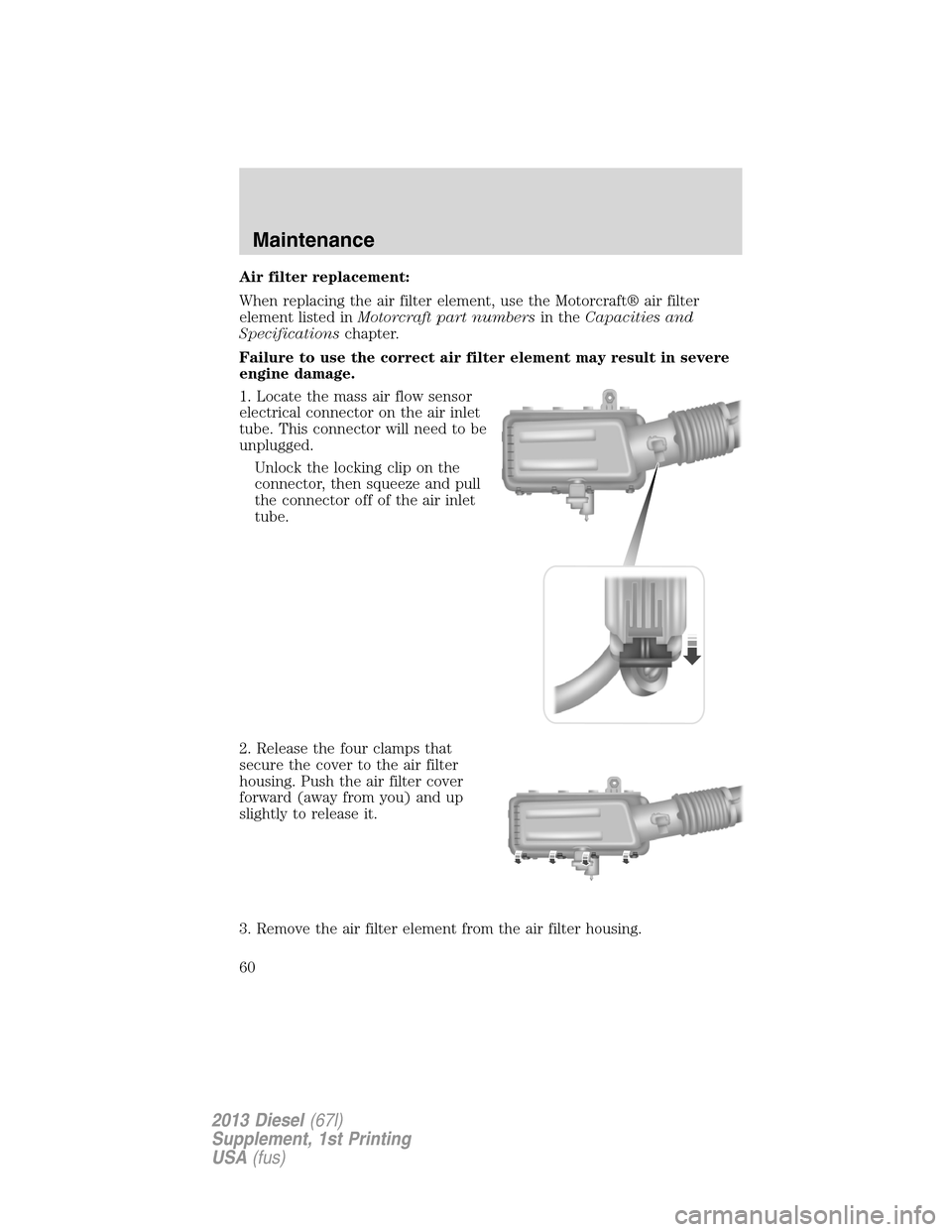
Air filter replacement:
When replacing the air filter element, use the Motorcraft® air filter
element listed inMotorcraft part numbersin theCapacities and
Specificationschapter.
Failure to use the correct air filter element may result in severe
engine damage.
1. Locate the mass air flow sensor
electrical connector on the air inlet
tube. This connector will need to be
unplugged.
Unlock the locking clip on the
connector, then squeeze and pull
the connector off of the air inlet
tube.
2. Release the four clamps that
secure the cover to the air filter
housing. Push the air filter cover
forward (away from you) and up
slightly to release it.
3. Remove the air filter element from the air filter housing.
Maintenance
60
2013 Diesel(67l)
Supplement, 1st Printing
USA(fus)
Page 62 of 95
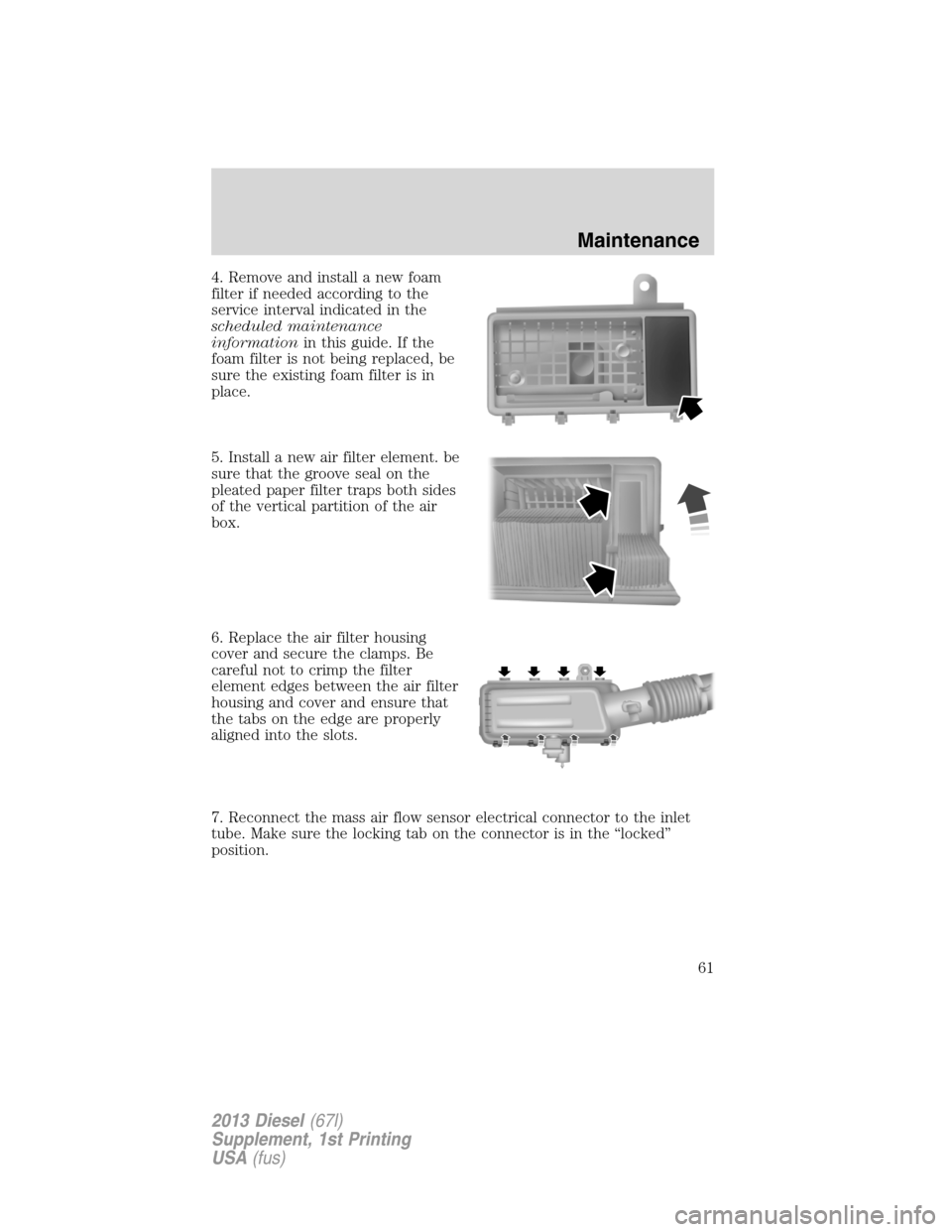
4. Remove and install a new foam
filter if needed according to the
service interval indicated in the
scheduled maintenance
informationin this guide. If the
foam filter is not being replaced, be
sure the existing foam filter is in
place.
5. Install a new air filter element. be
sure that the groove seal on the
pleated paper filter traps both sides
of the vertical partition of the air
box.
6. Replace the air filter housing
cover and secure the clamps. Be
careful not to crimp the filter
element edges between the air filter
housing and cover and ensure that
the tabs on the edge are properly
aligned into the slots.
7. Reconnect the mass air flow sensor electrical connector to the inlet
tube. Make sure the locking tab on the connector is in the “locked”
position.
Maintenance
61
2013 Diesel(67l)
Supplement, 1st Printing
USA(fus)
Page 63 of 95
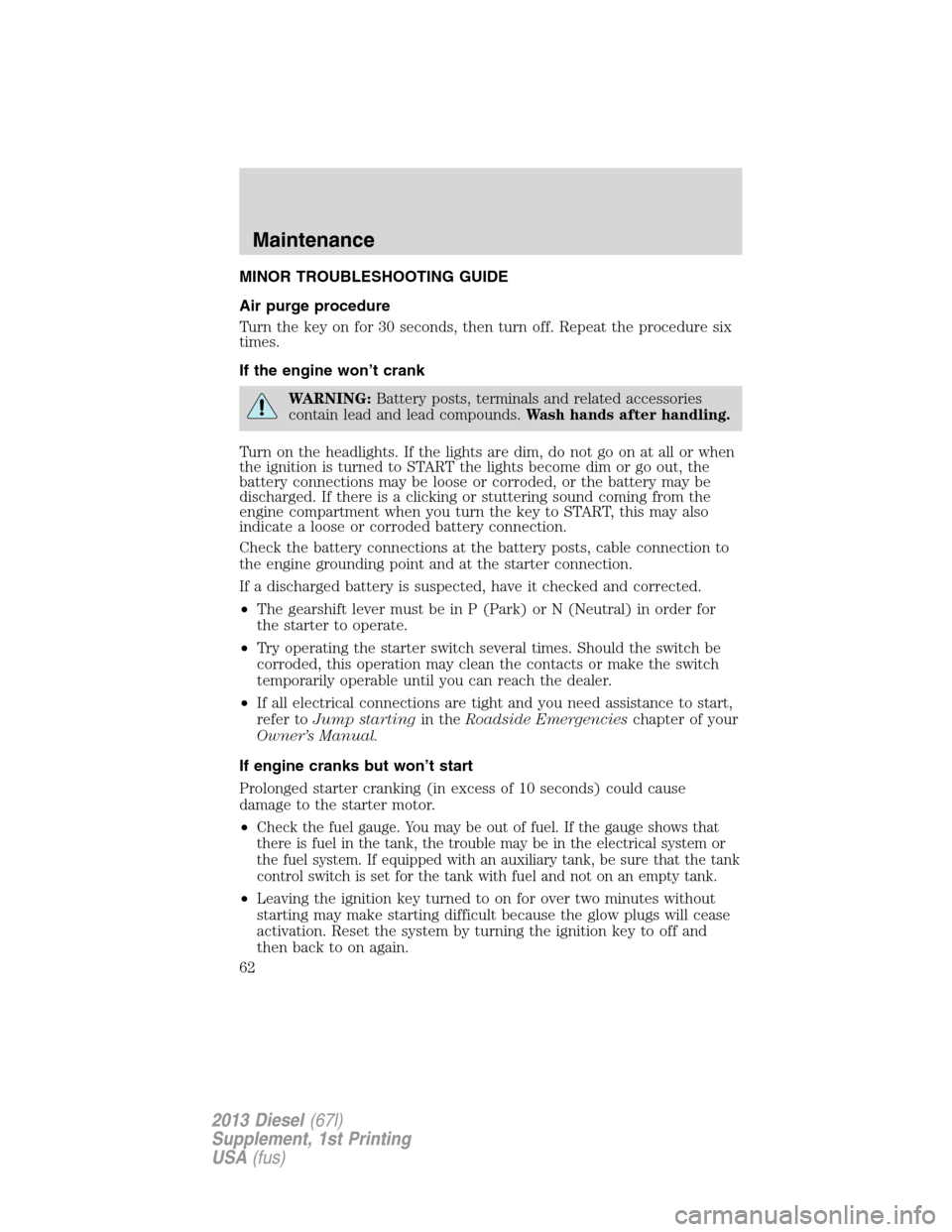
MINOR TROUBLESHOOTING GUIDE
Air purge procedure
Turn the key on for 30 seconds, then turn off. Repeat the procedure six
times.
If the engine won’t crank
WARNING:Battery posts, terminals and related accessories
contain lead and lead compounds.Wash hands after handling.
Turn on the headlights. If the lights are dim, do not go on at all or when
the ignition is turned to START the lights become dim or go out, the
battery connections may be loose or corroded, or the battery may be
discharged. If there is a clicking or stuttering sound coming from the
engine compartment when you turn the key to START, this may also
indicate a loose or corroded battery connection.
Check the battery connections at the battery posts, cable connection to
the engine grounding point and at the starter connection.
If a discharged battery is suspected, have it checked and corrected.
•The gearshift lever must be in P (Park) or N (Neutral) in order for
the starter to operate.
•Try operating the starter switch several times. Should the switch be
corroded, this operation may clean the contacts or make the switch
temporarily operable until you can reach the dealer.
•If all electrical connections are tight and you need assistance to start,
refer toJump startingin theRoadside Emergencieschapter of your
Owner’s Manual.
If engine cranks but won’t start
Prolonged starter cranking (in excess of 10 seconds) could cause
damage to the starter motor.
•
Check the fuel gauge. You may be out of fuel. If the gauge shows that
there is fuel in the tank, the trouble may be in the electrical system or
the fuel system. If equipped with an auxiliary tank, be sure that the tank
control switch is set for the tank with fuel and not on an empty tank.
•Leaving the ignition key turned to on for over two minutes without
starting may make starting difficult because the glow plugs will cease
activation. Reset the system by turning the ignition key to off and
then back to on again.
Maintenance
62
2013 Diesel(67l)
Supplement, 1st Printing
USA(fus)
Page 64 of 95
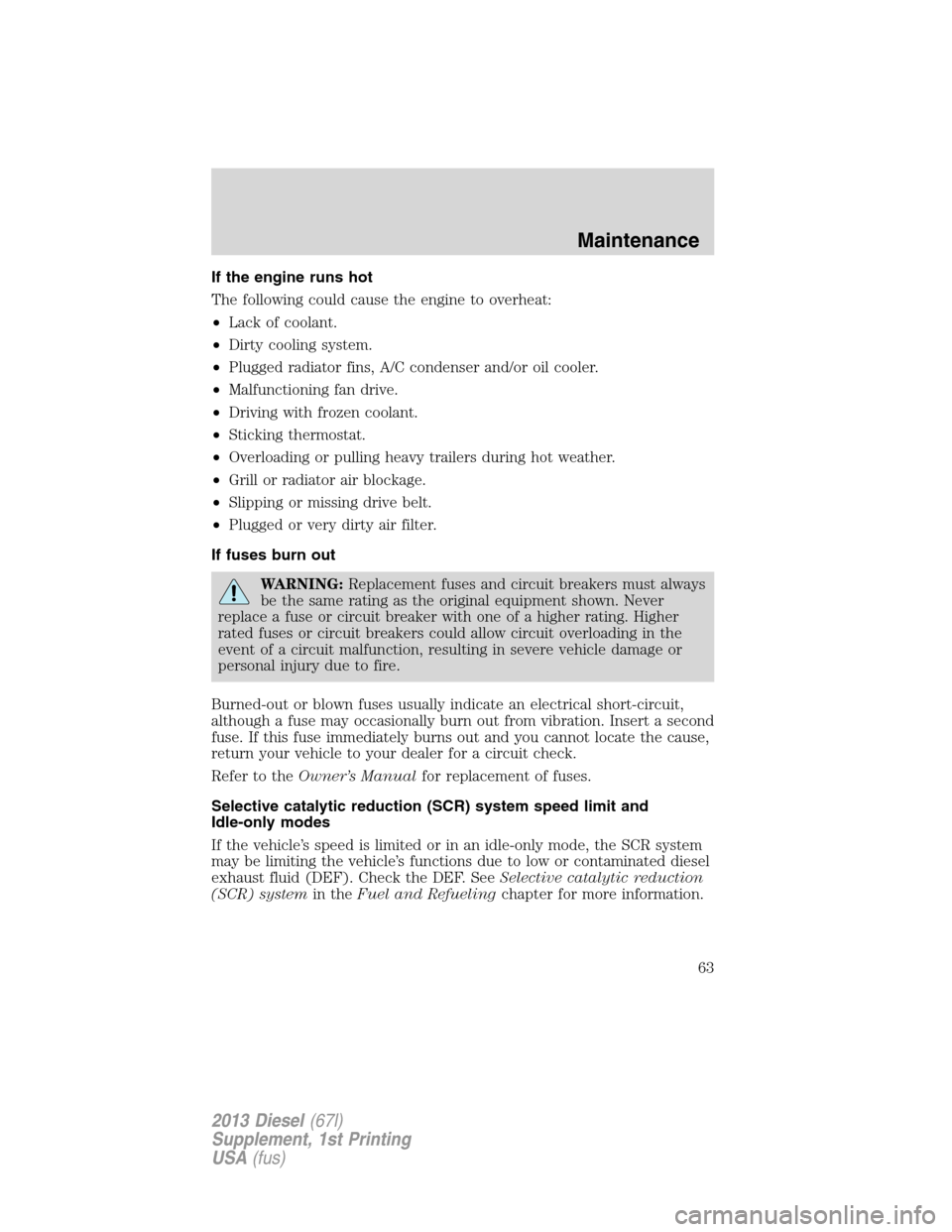
If the engine runs hot
The following could cause the engine to overheat:
•Lack of coolant.
•Dirty cooling system.
•Plugged radiator fins, A/C condenser and/or oil cooler.
•Malfunctioning fan drive.
•Driving with frozen coolant.
•Sticking thermostat.
•Overloading or pulling heavy trailers during hot weather.
•Grill or radiator air blockage.
•Slipping or missing drive belt.
•Plugged or very dirty air filter.
If fuses burn out
WARNING:Replacement fuses and circuit breakers must always
be the same rating as the original equipment shown. Never
replace a fuse or circuit breaker with one of a higher rating. Higher
rated fuses or circuit breakers could allow circuit overloading in the
event of a circuit malfunction, resulting in severe vehicle damage or
personal injury due to fire.
Burned-out or blown fuses usually indicate an electrical short-circuit,
although a fuse may occasionally burn out from vibration. Insert a second
fuse. If this fuse immediately burns out and you cannot locate the cause,
return your vehicle to your dealer for a circuit check.
Refer to theOwner’s Manualfor replacement of fuses.
Selective catalytic reduction (SCR) system speed limit and
Idle-only modes
If the vehicle’s speed is limited or in an idle-only mode, the SCR system
may be limiting the vehicle’s functions due to low or contaminated diesel
exhaust fluid (DEF). Check the DEF. SeeSelective catalytic reduction
(SCR) systemin theFuel and Refuelingchapter for more information.
Maintenance
63
2013 Diesel(67l)
Supplement, 1st Printing
USA(fus)
Page 65 of 95
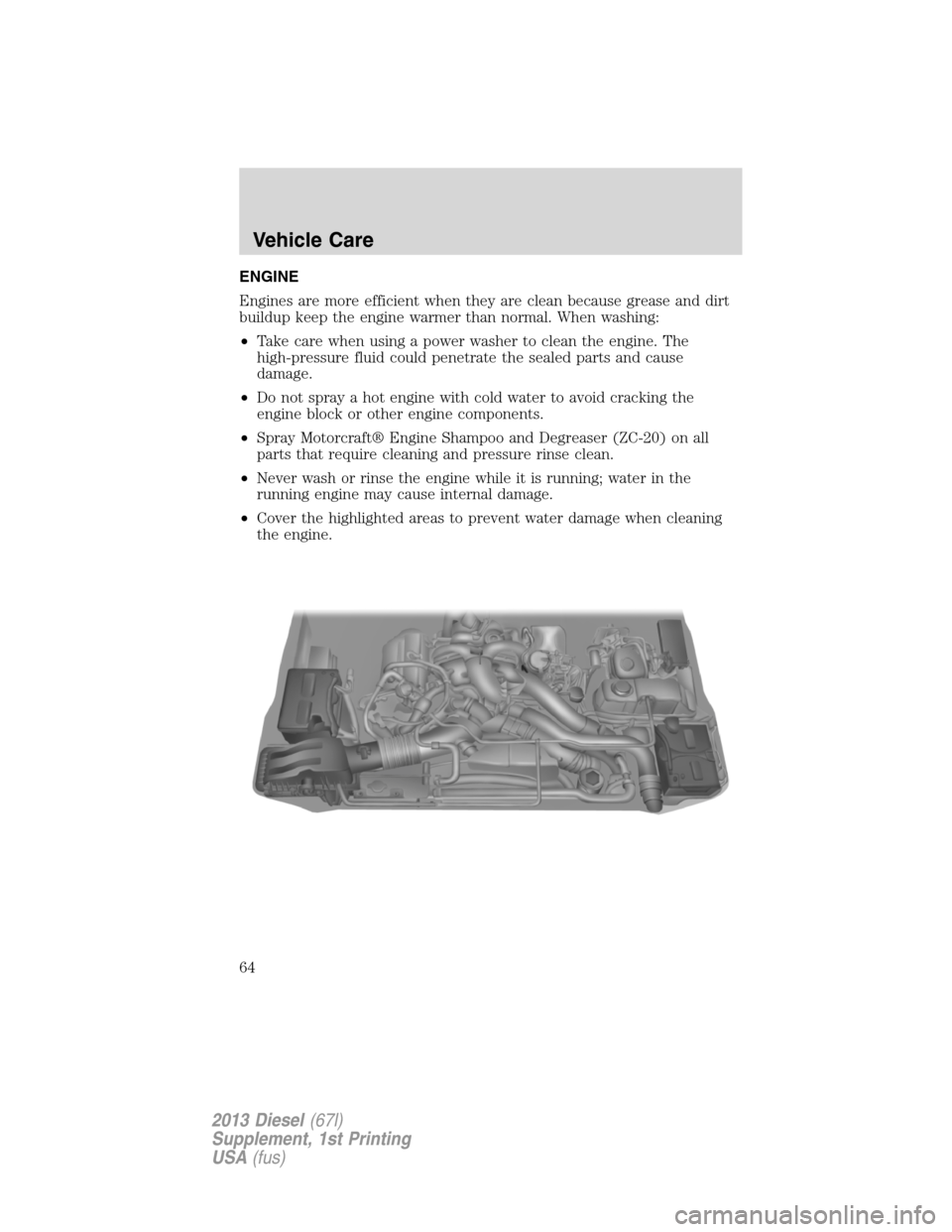
ENGINE
Engines are more efficient when they are clean because grease and dirt
buildup keep the engine warmer than normal. When washing:
•Take care when using a power washer to clean the engine. The
high-pressure fluid could penetrate the sealed parts and cause
damage.
•Do not spray a hot engine with cold water to avoid cracking the
engine block or other engine components.
•Spray Motorcraft® Engine Shampoo and Degreaser (ZC-20) on all
parts that require cleaning and pressure rinse clean.
•Never wash or rinse the engine while it is running; water in the
running engine may cause internal damage.
•Cover the highlighted areas to prevent water damage when cleaning
the engine.
Vehicle Care
64
2013 Diesel(67l)
Supplement, 1st Printing
USA(fus)
Page 66 of 95
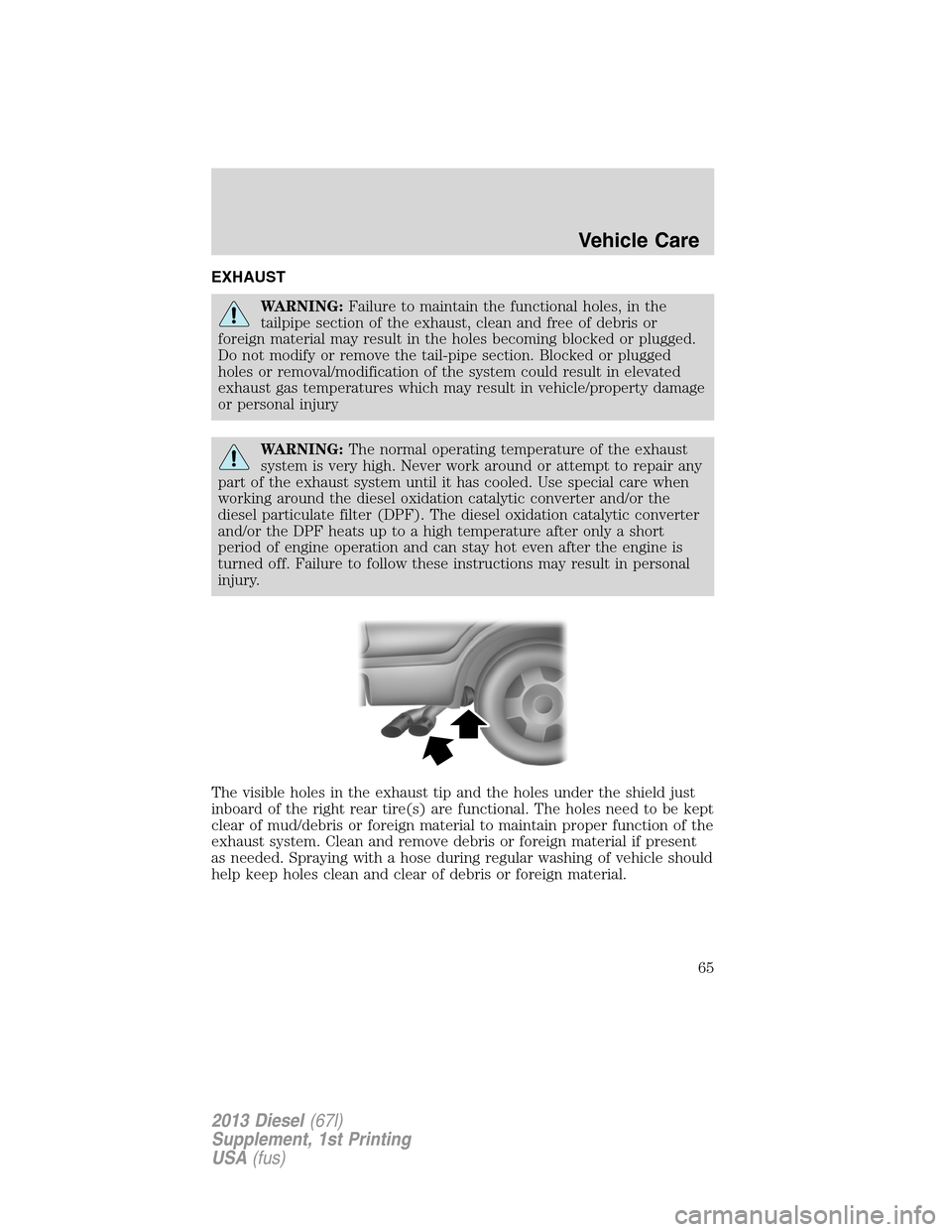
EXHAUST
WARNING:Failure to maintain the functional holes, in the
tailpipe section of the exhaust, clean and free of debris or
foreign material may result in the holes becoming blocked or plugged.
Do not modify or remove the tail-pipe section. Blocked or plugged
holes or removal/modification of the system could result in elevated
exhaust gas temperatures which may result in vehicle/property damage
or personal injury
WARNING:The normal operating temperature of the exhaust
system is very high. Never work around or attempt to repair any
part of the exhaust system until it has cooled. Use special care when
working around the diesel oxidation catalytic converter and/or the
diesel particulate filter (DPF). The diesel oxidation catalytic converter
and/or the DPF heats up to a high temperature after only a short
period of engine operation and can stay hot even after the engine is
turned off. Failure to follow these instructions may result in personal
injury.
The visible holes in the exhaust tip and the holes under the shield just
inboard of the right rear tire(s) are functional. The holes need to be kept
clear of mud/debris or foreign material to maintain proper function of the
exhaust system. Clean and remove debris or foreign material if present
as needed. Spraying with a hose during regular washing of vehicle should
help keep holes clean and clear of debris or foreign material.
Vehicle Care
65
2013 Diesel(67l)
Supplement, 1st Printing
USA(fus)
Page 67 of 95
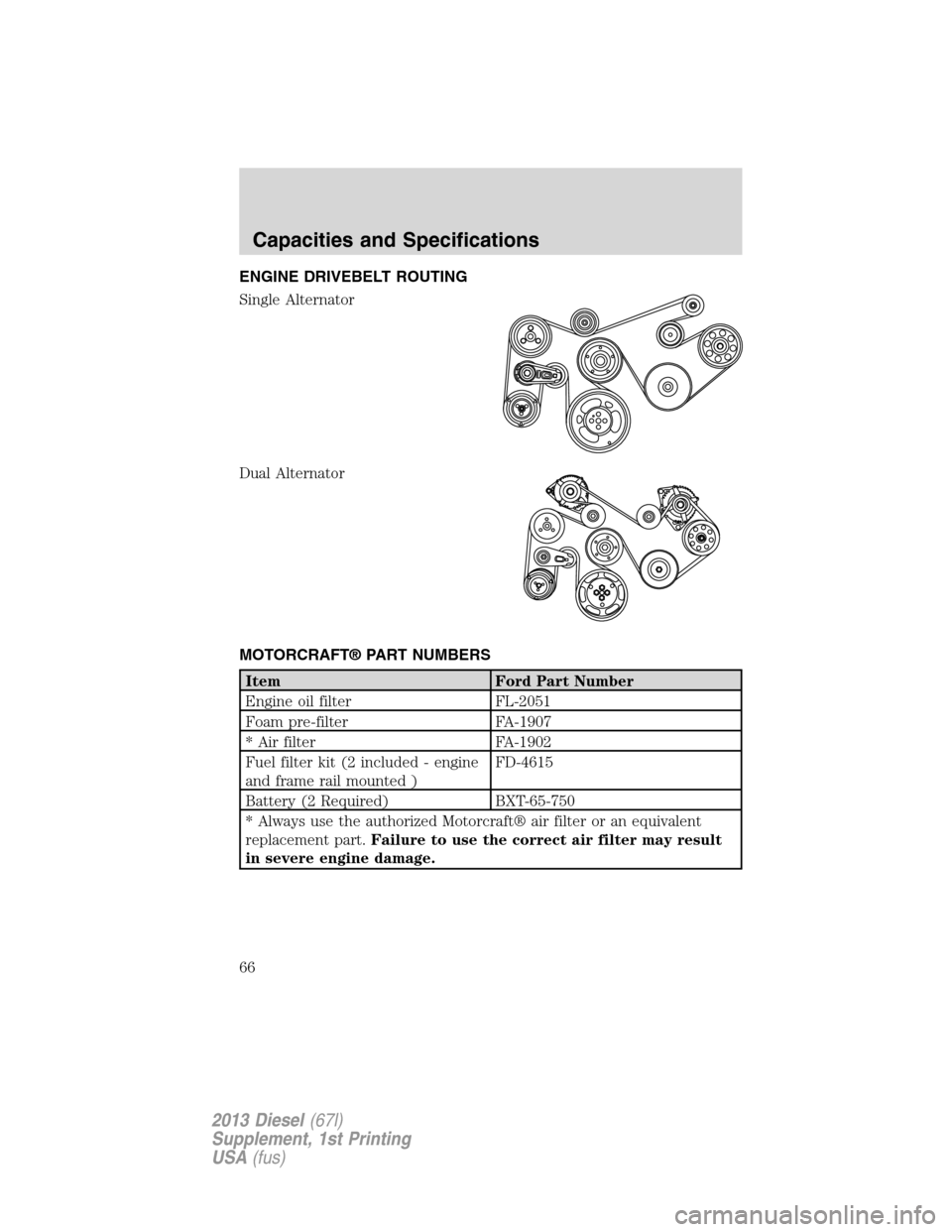
ENGINE DRIVEBELT ROUTING
Single Alternator
Dual Alternator
MOTORCRAFT® PART NUMBERS
Item Ford Part Number
Engine oil filter FL-2051
Foam pre-filter FA-1907
* Air filter FA-1902
Fuel filter kit (2 included - engine
and frame rail mounted )FD-4615
Battery (2 Required) BXT-65-750
* Always use the authorized Motorcraft® air filter or an equivalent
replacement part.Failure to use the correct air filter may result
in severe engine damage.
Capacities and Specifications
66
2013 Diesel(67l)
Supplement, 1st Printing
USA(fus)
Page 68 of 95
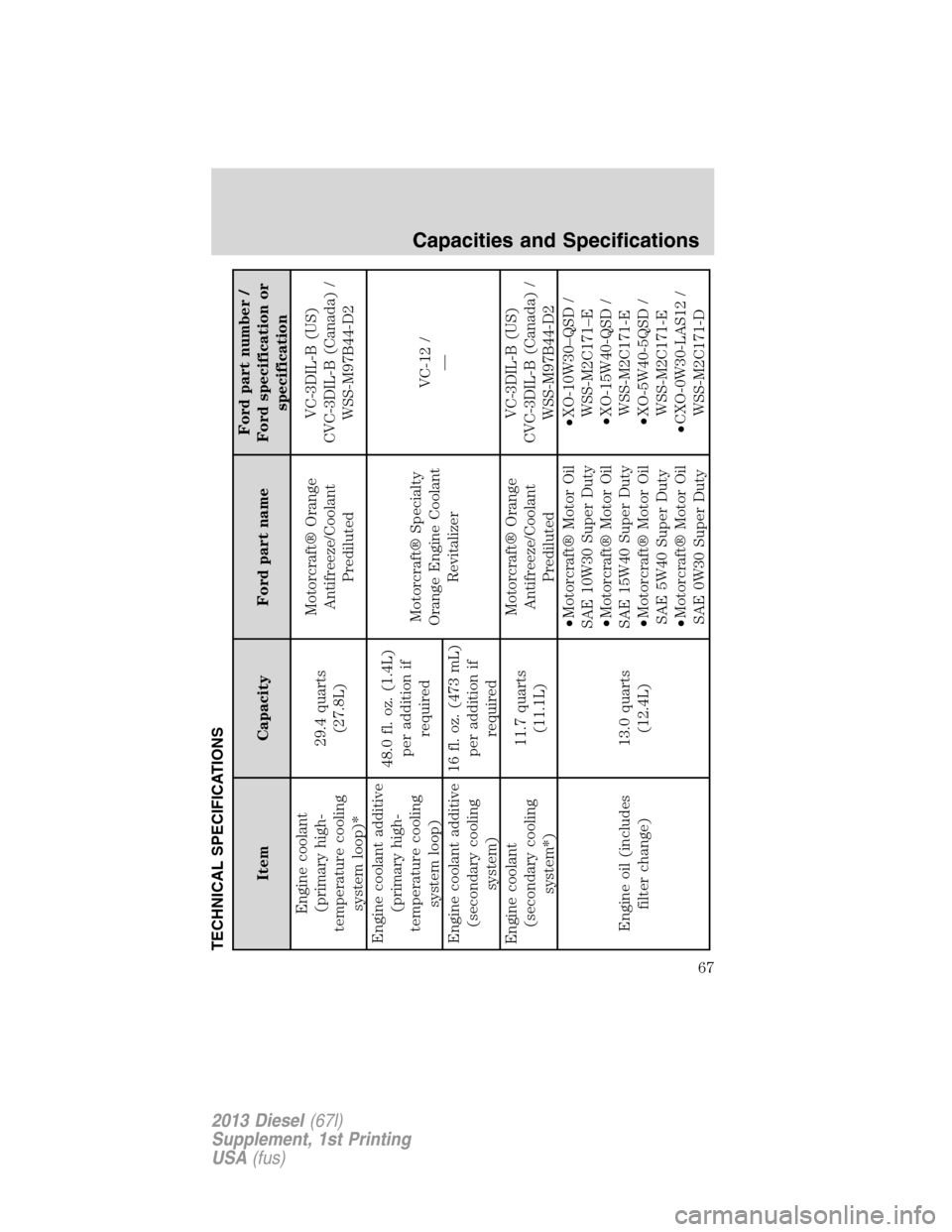
TECHNICAL SPECIFICATIONS
Item Capacity Ford part nameFord part number /
Ford specification or
specification
Engine coolant
(primary high-
temperature cooling
system loop)*29.4 quarts
(27.8L)Motorcraft® Orange
Antifreeze/Coolant
PredilutedVC-3DIL-B (US)
CVC-3DIL-B (Canada) /
WSS-M97B44-D2
Engine coolant additive
(primary high-
temperature cooling
system loop)48.0 fl. oz. (1.4L)
per addition if
requiredMotorcraft® Specialty
Orange Engine Coolant
RevitalizerVC-12 /
—
Engine coolant additive
(secondary cooling
system)16 fl. oz. (473 mL)
per addition if
required
Engine coolant
(secondary cooling
system*)11.7 quarts
(11.1L)Motorcraft® Orange
Antifreeze/Coolant
PredilutedVC-3DIL-B (US)
CVC-3DIL-B (Canada) /
WSS-M97B44-D2
Engine oil (includes
filter change)13.0 quarts
(12.4L)•Motorcraft® Motor Oil
SAE 10W30 Super Duty
•Motorcraft® Motor Oil
SAE 15W40 Super Duty
•Motorcraft® Motor Oil
SAE 5W40 Super Duty
•Motorcraft® Motor Oil
SAE 0W30 Super Duty•XO-10W30–QSD /
WSS-M2C171–E
•XO-15W40-QSD /
WSS-M2C171-E
•XO-5W40-5QSD /
WSS-M2C171-E
•CXO-0W30-LAS12 /
WSS-M2C171-D
Capacities and Specifications
67
2013 Diesel(67l)
Supplement, 1st Printing
USA(fus)
Page 69 of 95
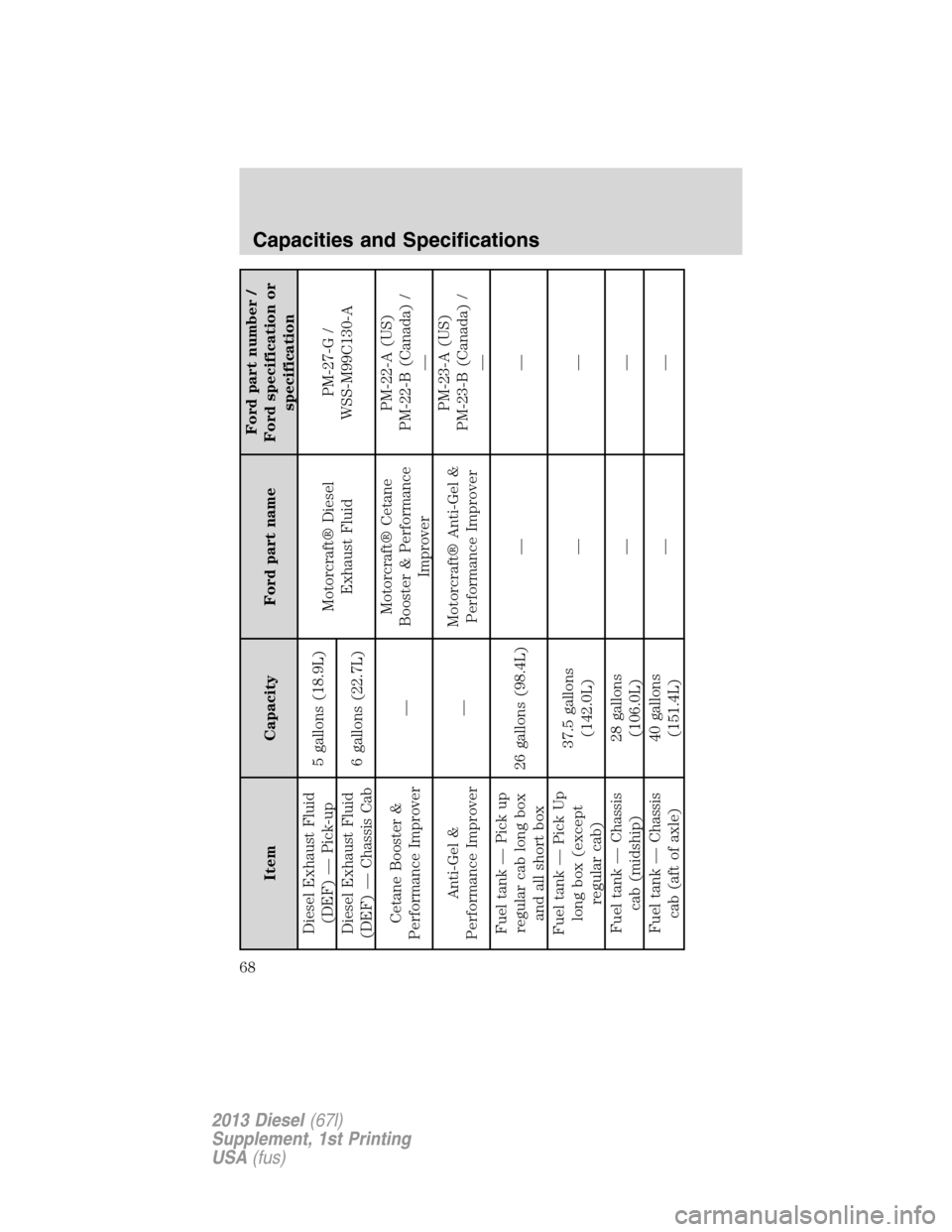
Item Capacity Ford part nameFord part number /
Ford specification or
specification
Diesel Exhaust Fluid
(DEF) — Pick-up5 gallons (18.9L)
Motorcraft® Diesel
Exhaust FluidPM-27-G /
WSS-M99C130-A
Diesel Exhaust Fluid
(DEF) — Chassis Cab6 gallons (22.7L)
Cetane Booster &
Performance Improver—Motorcraft® Cetane
Booster & Performance
ImproverPM-22-A (US)
PM-22-B (Canada) /
—
Anti-Gel &
Performance Improver—Motorcraft® Anti-Gel &
Performance ImproverPM-23-A (US)
PM-23-B (Canada) /
—
Fuel tank — Pick up
regular cab long box
and all short box26 gallons (98.4L) — —
Fuel tank — Pick Up
long box (except
regular cab)37.5 gallons
(142.0L)——
Fuel tank — Chassis
cab (midship)28 gallons
(106.0L)——
Fuel tank — Chassis
cab (aft of axle)40 gallons
(151.4L)——
Capacities and Specifications
68
2013 Diesel(67l)
Supplement, 1st Printing
USA(fus)
Page 70 of 95
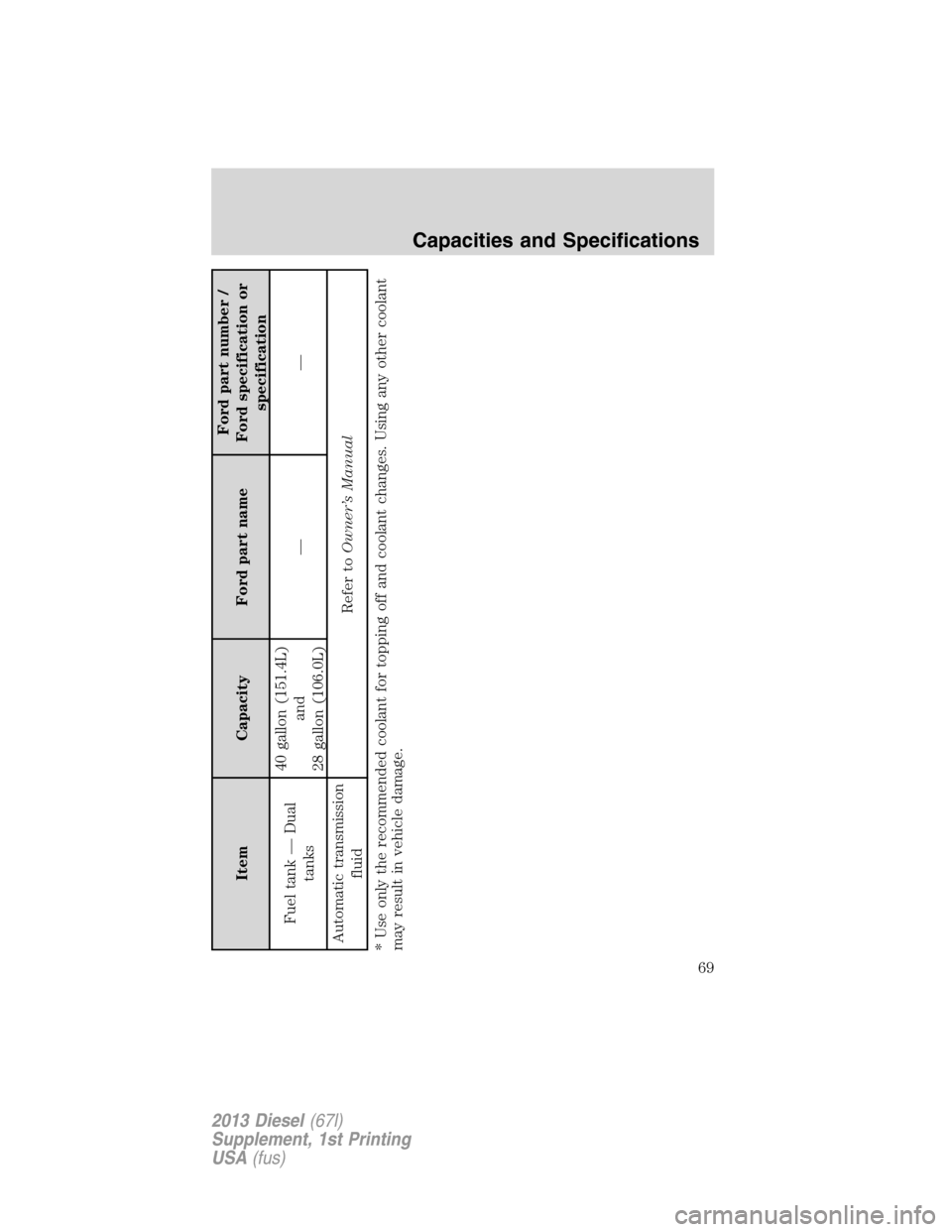
Item Capacity Ford part nameFord part number /
Ford specification or
specification
Fuel tank — Dual
tanks40 gallon (151.4L)
and
28 gallon (106.0L)——
Automatic transmission
fluidRefer toOwner’s Manual
* Use only the recommended coolant for topping off and coolant changes. Using any other coolant
may result in vehicle damage.
Capacities and Specifications
69
2013 Diesel(67l)
Supplement, 1st Printing
USA(fus)